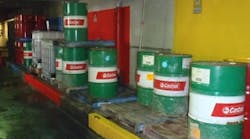I’ve always read and seen great pictures of companies with fantastic-looking lubrication color coding systems. I thought how great it would be to work in one of those rare environments. I just didn’t have time to do one myself, nor did I really know where to start. Until one day, my lubrication technician (John, who was recently certified as an MLT1) said he wanted to get one going. We estimated about $2,000 funding was needed; a tiny percentage of a maintenance budget. It sounded good so far, and I agreed.
We got the accountant to give us a list of all the lubricants we had purchased in the past 18 months. John and I quickly went through the list and identified each oil as either a paper machine oil (PMO), a mineral gear oil (EP), a synthetic gear oil (EP-S), a hydraulic oil (AW), a turbine oil (R&O), or a chain oil (CHN). We did the same for greases, identifying each as a motor grease (EM), multipurpose grease (MP), wet area grease (W), or coupling grease (C).
For each lubricant application type, we chose a color. We chose blue for PMO, yellow for EP, black for EP-S, red for AW, grey for R&O, and green for CHN oils. I am a great fan of the OilSafe containers, and we made sure the oil colors we chose matched available OilSafe container lid colors. We also chose purple for EM, green for MP, pink for W, and brown for C greases.
From the same accountant’s list, we then worked out the different viscosities of each oil. We had 22, 32, 46, 68, 100, 150, 220, 320, 460, and 680 viscosity oils. We decided to use shapes to differentiate between viscosities. We allocated 22 = trapezium, 32 = inverted triangle, 46 = rhombus, 68 = triangle, 100 = pentagon, 150 = diamond, 220 = square, 320 = circle, 460 = hexagon, and 680 = star. We did a similar thing for greases, shape coding the NLGI numbers for each grease type.
Wherever drums or totes of oil were stored, the floor and wall were painted in the applicable color for that lubricant type.
We then put it all together in Microsoft Excel, using the well-known and simple drawing, shape, and color tools to make up the labels. We even left a space at the bottom of the label to write on the equipment name and a space for the lubricant product name. The latter is optional, as we knew a lot of companies prefer describing only the lubricant properties and being product neutral, however we decided to ensure there was absolutely no confusion, we opted to include lubricant product names.
We then got onto Google and searched for “aluminum label manufacture.” Numerous companies popped up, and, after looking at a few of their websites, we chose six candidates. We selected two from Australia, one from the United States, one from the United Kingdom, and two from China. We emailed them the Excel file and asked for some quotes. They came back with questions about adhesives and aluminum thicknesses, so I asked for a few samples. We then ran trials on five different adhesives on our hottest and wettest pump. The 1 mm sponge glue type worked perfectly, almost impossible to remove once applied onto a clean surface. We also opted for a 0.3 mm thickness label; it was thick enough to handle day-to-day abuse, but thin enough to be able to contour to rounded surfaces like motor cowlings.
We were ready to finalize the quotes. Prices varied considerably. It’s amazing the deals you can get if you shop around. We ordered 2,500 labels to cover all of our equipment on-site, from motors and fans to hydraulic tanks and gearboxes. The price was around $1,000, including freight charges.
A few weeks later, the labels arrived. John, our lube tech, a few fitters during their daily inspection rounds, and I began sticking on the labels. It took about two months to get them all in place, but, with a few labels a day, a little bit goes a long way, and the benefits could soon be realized.
| Lee Taylor is national reliability manager at Visy Paper, a packaging, paper, and recycling company based in Melbourne, Australia. Email him at [email protected]. |
As an addition to the color coding program, we bought five tins of oil-based heavy traffic non-slip paint. We bought red, blue, grey, yellow, green, and black. Wherever we stored drums or totes of oil around our site, other than in our lubrication store, we chose a dedicated area and painted the floor and wall in the applicable color for that lubricant type. We also applied a color-coded label to the wall. For minimal investment in some paint for $500, we had the beginnings of a world class 5S system in place for lubricant storage.
We then spent $500 on the OilSafe containers and applied a color-coded label to each container, depending on which lubricant it contained. This really polished off the program to a very high standard.
With very minimal input from me and less than $2,000, we transformed our plant from a lower-performing plant, in terms of color coding, 5S, and cross-contamination control, to a world’s best-practice site, incorporating a fantastic color-coding system, high-quality labels, 5S lubricant storage, and top-class oil transfer containers. We also reduced our cross contamination to zero incidents in the nine months following completion.
